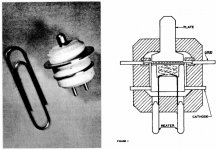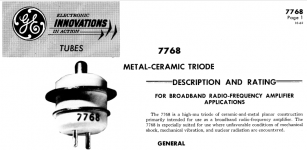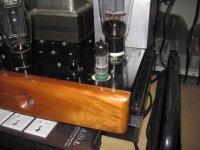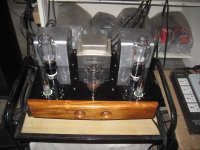You can use 12AT7, thats fair enough.
In the german AAA audio forum, someone build a 211 SET amp with a single 12AT7 driver tube.
If thats enough gain for a 211, its far overkill for a simple 300B tube.
If you just want a technical solution and love whimsy driver tubes, got that way.
In the german AAA audio forum, someone build a 211 SET amp with a single 12AT7 driver tube.
If thats enough gain for a 211, its far overkill for a simple 300B tube.
If you just want a technical solution and love whimsy driver tubes, got that way.
You can use 12AT7, thats fair enough.
In the german AAA audio forum, someone build a 211 SET amp with a single 12AT7 driver tube.
If thats enough gain for a 211, its far overkill for a simple 300B tube.
If you just want a technical solution and love whimsy driver tubes, got that way.
I like beefy driver tubes like the EL33, mu of 20. Just not enough in itself for a 2-stage amp driving a 300b. I have no taste for "whimsy" driver tubes with plenty of gain and very little current if that's what you mean. My ears tell me that current matters. I don't know all the theory about slew rate etc but I just hear more punchy bass and clearer mids and highs with currents around 15mA as a ballpark, sometimes even more. I think this was the Sakuma approach from what I read.
parallel 6EJ7 in triode? mu ca 55
http://edi.bplaced.net/images/projekte/2014_Projekt_Pendler/2014-05-11-8_EF184_als_Triode.jpg
http://edi.bplaced.net/images/projekte/2014_Projekt_Pendler/2014-05-11-8_EF184_als_Triode.jpg
I like beefy driver tubes like the EL33, mu of 20. Just not enough in itself for a 2-stage amp driving a 300b. I have no taste for "whimsy" driver tubes with plenty of gain and very little current if that's what you mean. My ears tell me that current matters. I don't know all the theory about slew rate etc but I just hear more punchy bass and clearer mids and highs with currents around 15mA as a ballpark, sometimes even more. I think this was the Sakuma approach from what I read.
yes, size matters when it comes to tubes. I am not talking about Freudian factors, but rather generous and spaced structures within the tube that result in a capability with high linearity. Although the use of beefy tubes as drivers has a long legacy prior to World War II, Sakuma's "same tube for driver and power" scored the points excellently. No tube is too big or too strong to be used as a driver, and the driver should better be similar in size or a tad smaller than the output tube. The mighty 845 is not powered by a 9-pin light bulb. No, it doesn't have to be the exact same tube for driver and output (Sakuma wasn't and is not overly dogmatic), but it's a good starting point for design exploration.
No need,just hover your cursor over the image.
Doesn't work for me! Please just say what it is.
Doesn't work for me! Please just say what it is.
Oh! Sorry it's a 7768
Attachments
If it makes NO Sense to you, than, if I were you, would not shout this out to the world of internet.Not for the first time you won the day prize for posting nonsense 😱🙄
Sometimes, its more clever to remain in silence, if one doesn't understand other peoples concepts.
Sakuma San (RIP) was a well reputed tube amp designer in the asian world (greatest community in the world of tube audio).
Maybe you've never heard of him.
P. S. Those were not my words, but a translation that describes his concept ideas.
But if you prefer to go by the textbook, just choose a whimsy driver tube, it would work already.
Last edited:
I know the works of Sakuma San very well; actually I built amplifiers based on his concepts.
Sakuma strived for a particular sound; perfectly OK.
Drawback of using power tubes to drive power tubes is lack of the necessary voltage gain.
Sakuma used step up transformers to compensate.
However, HF bandwidth suffer, so the result is a bandwidth limited amplifier, not HiFi.
If you can live with it, you have my blessing.
IMO good amplifiers should meet basic HiFi specifications; Sakuma amps are not in that category.
Sakuma strived for a particular sound; perfectly OK.
Drawback of using power tubes to drive power tubes is lack of the necessary voltage gain.
Sakuma used step up transformers to compensate.
However, HF bandwidth suffer, so the result is a bandwidth limited amplifier, not HiFi.
If you can live with it, you have my blessing.
IMO good amplifiers should meet basic HiFi specifications; Sakuma amps are not in that category.
Drawback of using power tubes to drive power tubes is lack of the necessary voltage gain. Sakuma used step up transformers to compensate.
However, HF bandwidth suffer, so the result is a bandwidth limited amplifier, not HiFi.
Since this is a thread about 2 stage amps, the whole question of gain is pretty central. But though it's true that there are few power tubes that have a mu of more than around 12 in triode, there are a small number of exceptions. I've been using EL12n tubes, for instance. Good sounding tubes which could be used as either outputs or drivers or both. Come down a bit in power and you have EL84s in triode, KT61, EL33 and some others. Here we're talking a mu of 15-18. Easy to use a couple of these to make a 2 stage amplifier.
Once you let go of the idea that power tubes don't have much gain you start to see possible combinations. That's what I've been doing recently and getting good results.
As mentioned D3a and C3m / C3o / C3g are good. But don't overlook the high-gm video amp pentodes like 12GH7/12GN7. It's a bit dated but there's some test data here: High Gm driver pentodes
yes...... and i would even use the el84 in pentode mode...
The Siemens C3G does very well in triode. I used it once with a 1:1 transformer, to drive the 300.
Most (all?) penthodes indeed sound whimpy and too soft, driving it. I did find it hard to make the C3G transparent: you can hear lots of changes in SQ, depending on how and with what (decoupling caps, resistor types etc) you wire the thing up. Never did hear a tube that could play music without aounding like the average tube amp, and I mean that in all sincerity.
Btw iirc, the 300 should only be called 300b if there's a bajonet for the socket ;-)
Most (all?) penthodes indeed sound whimpy and too soft, driving it. I did find it hard to make the C3G transparent: you can hear lots of changes in SQ, depending on how and with what (decoupling caps, resistor types etc) you wire the thing up. Never did hear a tube that could play music without aounding like the average tube amp, and I mean that in all sincerity.
Btw iirc, the 300 should only be called 300b if there's a bajonet for the socket ;-)
Nearly 20 years ago I built the typical (at the time) three stage, 6SN7 driving a 300B powered by a 5U4 amp. No matter what I did to it I just couldn't listen to it for extended periods of time without getting irritated. Measurements revealed low level IMD, and IMD between applied signal and 60/120/180 Hz.
Eventually I built a push pull 300B amp which I still have.
I then set out to design my own two stage SET amp. I found that a decent triode with a Mu of 40 or better with a CCS load and a follower as a buffer to remove the load of the DHT grid sounded and measured best. DC heating was used to remove all hum and PS related IMD. Several iterations later that amp became the TSE, and now the TSE-II.
Several hundred TSE's have been built, and it is a well received amp.
Both of these look similar to the TSE design.
It might be "horrible" but it works pretty good.
Back in the design phase of the TSE I tried probably 50 different tubes for the driver. I settled on the 5842 / WE417A because it worked better than anything else that I tried, and was pretty common and under $5 each. Unfortunately they are getting more expensive lately, but Stan at ESRC had them for $10 each before he passed. The D3A works good when triode wired, but is rare in the US. Tubes like the 12AT7 and 12AX7 can work very well when CCS loaded and buffered, but there are lots of different flavors of these tubes, and some just suck!
Eventually I built a push pull 300B amp which I still have.
I then set out to design my own two stage SET amp. I found that a decent triode with a Mu of 40 or better with a CCS load and a follower as a buffer to remove the load of the DHT grid sounded and measured best. DC heating was used to remove all hum and PS related IMD. Several iterations later that amp became the TSE, and now the TSE-II.
What you'll end up (and all others, who try this attempt) is a whimsy sounding amp. It might function, generally and theorectical.
Several hundred TSE's have been built, and it is a well received amp.
I use this for -more than- a decade.
Some years ago I built a 300B for my friend with C3g.
Both of these look similar to the TSE design.
euro21, I find your approach horrible.
It might be "horrible" but it works pretty good.
Back in the design phase of the TSE I tried probably 50 different tubes for the driver. I settled on the 5842 / WE417A because it worked better than anything else that I tried, and was pretty common and under $5 each. Unfortunately they are getting more expensive lately, but Stan at ESRC had them for $10 each before he passed. The D3A works good when triode wired, but is rare in the US. Tubes like the 12AT7 and 12AX7 can work very well when CCS loaded and buffered, but there are lots of different flavors of these tubes, and some just suck!
- Home
- Amplifiers
- Tubes / Valves
- 300b with single stage driver, C3M or?



